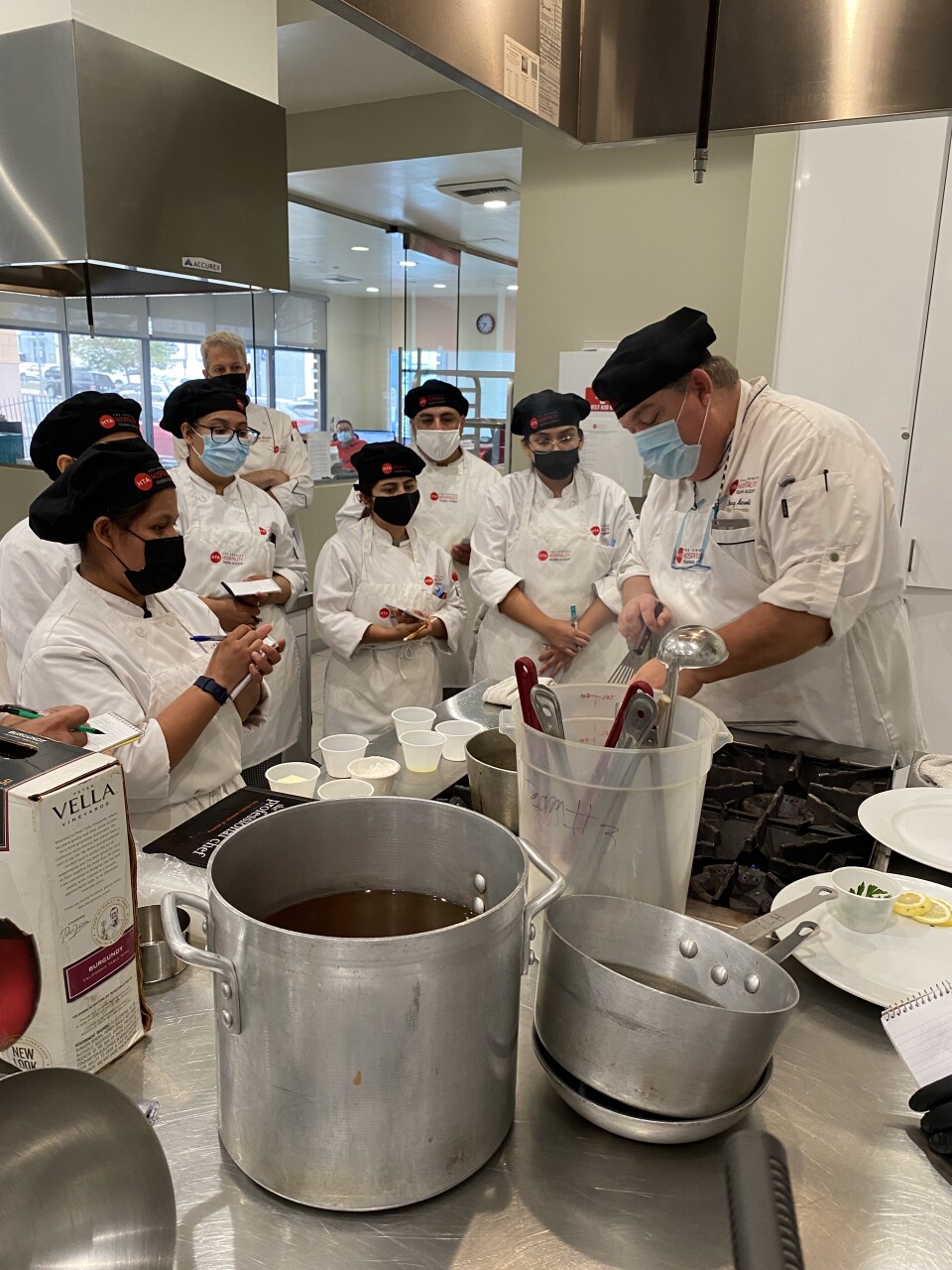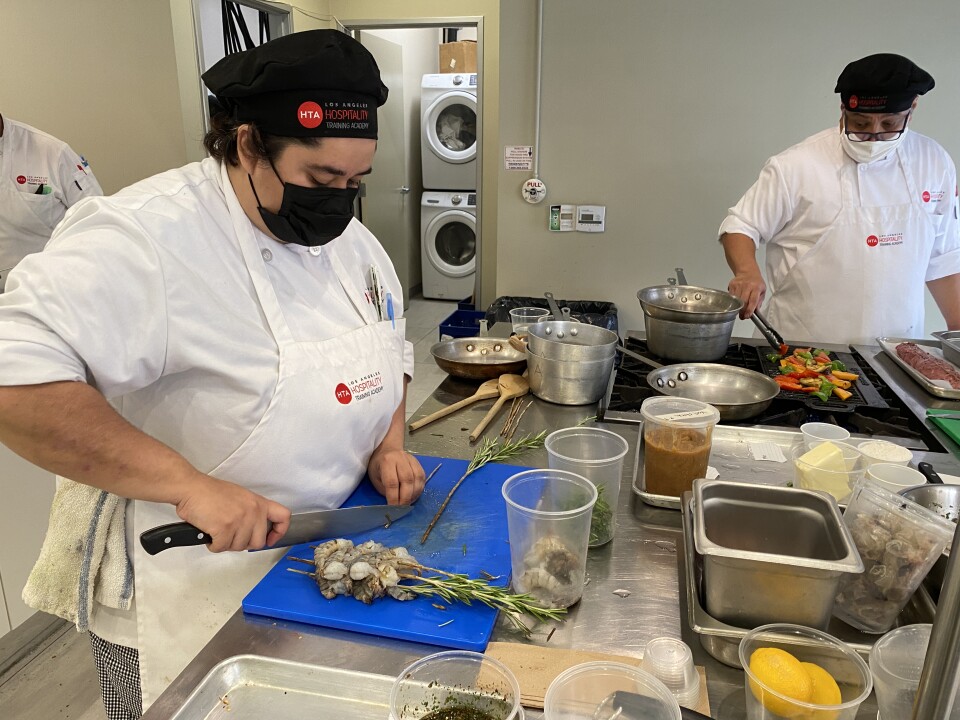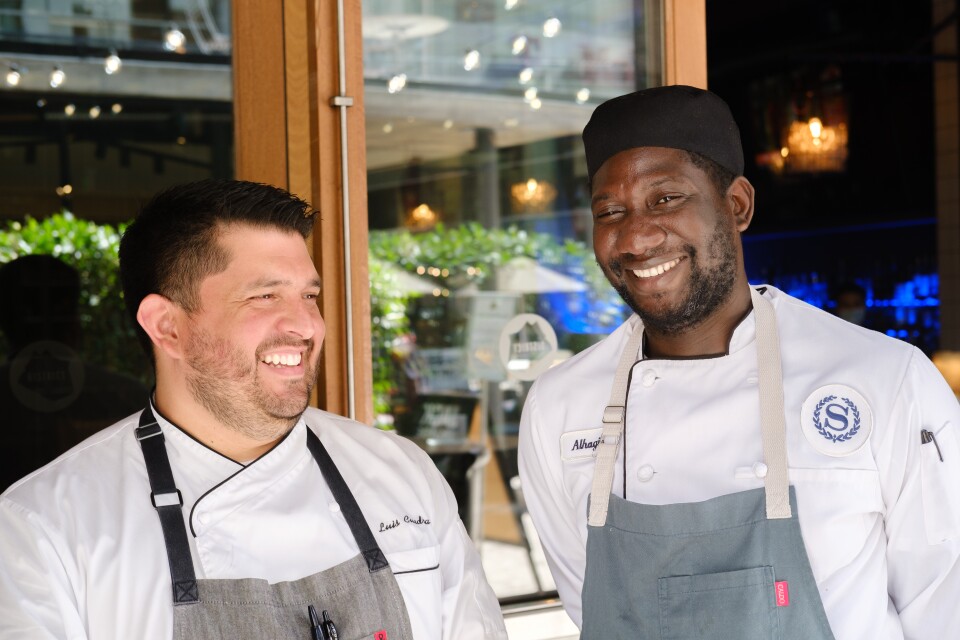Truth matters. Community matters. Your support makes both possible. LAist is one of the few places where news remains independent and free from political and corporate influence. Stand up for truth and for LAist. Make your year-end tax-deductible gift now.
An Apprenticeship Is A Money-Saving Path To Become A High-Paid Chef. Here's How It Works

Alhagie Dampha's first job in a restaurant after coming to Los Angeles from his native Gambia in 2016 was at Chipotle, grilling steak and mixing guacamole for minimum wage. As is the case for many low-paid food workers, the job was a way to, hopefully, get somewhere else: Dampha was also taking classes at El Monte-Rosemead Adult School with the goal of becoming a pharmacy technician.
"I was going to school from 8 a.m. to 2 p.m. and then work from 3 p.m. to 11 p.m.," Dampha told me. "I would get home at like midnight, do my homework until 2 in the morning, and go to sleep."
What Dampha really wanted was a career in the kitchen. When his then-wife came home with a brochure advertising a culinary apprenticeship, with orientation the following day, he dropped everything.
Read more from our series
- An Apprenticeship Is A Money-Saving Path To Become A High-Paid Chef. Here's How It Works
- Where Are All The Women Electricians, Plumbers, Carpenters?
- Nursing Apprenticeship Gives State Health Care Workers A Career Boost
- Apprenticeship: What Is it? How Do I Find One?
- Early Childhood Apprenticeships Build A Skilled Workforce, But Where’s The Pay?
"I was like this is the moment I've been waiting for, so I just jumped in," he said.
Three years later, Dampha, 34, works in the kitchen at the downtown Sheraton Grand Los Angeles — where he earns almost twice as much as he did at Chipotle — and also at the popular Joey DTLA. His ultimate goal is to become an executive chef, which can fetch a six-figure salary at L.A. restaurants. He credits his upward career trajectory largely to his apprenticeship.
Earning While Learning
Apprenticeships train students on the job, and pay them while they're learning. As the price of college rises, and the earnings gap widens between college-educated Californians and those without a college degree, state leaders are looking to expand apprenticeships as an alternative path to upward mobility. They're also banking on apprenticeships to help replace an aging workforce and ensure that workers have up-to-date training in a rapidly evolving economy.
"I think our country has been really behind and not necessarily grasped what many other modernized countries have, like Switzerland and Germany and the UK, all of whom have embedded the registered apprenticeship model as their gold standard for learning," said Kelly Mackey, a regional director for apprenticeship and workforce innovation at California's Department of Industrial Relations.
In Switzerland, which ranks high on per-capita income and relatively low on income inequality, about two-thirds of students pursue apprenticeships and other forms of vocational training rather than a baccalaureate degree.

The apprenticeship that helped Dampha launch his culinary career is geared toward people who have historically been relegated to low-pay, low-prestige restaurant jobs, including immigrants and people of color. It's sponsored by UNITE HERE Local 11, the union that represents more than 32,000 restaurant and hospitality workers in Southern California and Arizona.
The apprenticeship starts at the union's Hospitality Training Academy, where apprentices spend eight weeks learning classical French cooking techniques and sauces. They typically finish out their year- to year-and-a-half-long apprenticeship (apprenticeship rules require they work at least 1,000 hours) in a unionized kitchen at places like the Staples Center, LAX and the downtown Sheraton.
"I think our country has been really behind and not necessarily grasped what many other modernized countries have, like Switzerland and Germany and the UK, all of whom have embedded the registered apprenticeship model as their gold standard for learning."
On a recent morning, 12 apprentices took notes while watching instructor Danny Harold demonstrate how to perfectly cook sole meunière. "We're trying to achieve a nice little golden crust on top here," he explained, "but this fish is thin, so we're under a timeline. The fish will overcook. So we have to be able to brown our fish, make our sauce, complete the entire dish without overcooking, which means our mise en place has to be ready."
This apprenticeship cohort, which is half the usual size because of COVID-19 safety protocols, went through a substantial vetting process — from among some 200 people who initially expressed interest in the program. The vetting included multiple interviews and a kitchen math skills class.
Rigor Required
Program leaders say the process helps weed out people who aren't fully committed to a career as a chef. Apprentice Nicole Rios, 29, has wanted to go to culinary school since her freshman year in high school. But when her dad was deported to Mexico, she and the rest of her family went with him, and she put the dream on hold.
"Culinary school in Mexico is very different," Rios said. "It was far more expensive and the training was far less."

Rios eventually moved back to Los Angeles and got her associate degree in studio arts from East Los Angeles College. "But the kitchen was always calling me back," she said. Rios worked at a Subway and a Taiwanese bakery before stumbling upon the culinary apprenticeship. "And I was like, 'This is perfect. It's everything I want to learn and it's free.'"
Halfway into her time at the Hospitality Training Academy, Rios had already secured a job in the Staples Center kitchen to continue her apprenticeship, making substantially more — and, she hopes, in a more fulfilling environment — than her prior kitchen jobs. "I'm looking to get my foot in the door in a good kitchen and like, actually grow," she said.
Employers Ask 'Can They Start Working Now?'
Mitchell Frieder, the lead instructor for the culinary apprenticeship program, said all apprentices typically land jobs by the end of the classroom training period at the Hospitality Training Academy. "And with COVID running, the employers are saying, 'Can they start working now?'"
Employers like the program because of the rigorous — and especially, as required by apprenticeship rules, standardized — curriculum. Manny Slomovits, senior executive chef at the Staples Center, said he considers the apprenticeship curriculum a condensed version of what he learned as a student at the prestigious Culinary Institute of America.

Slomovits comes to recruit directly from apprenticeship classes here because it gives him a chance to see potential employees in action. "The proof is right there," he said. "You can see the knife skills, you can see what's written on the board," which, at the time, was the list of ingredients for bordelaise sauce. "I'm about to taste it," Slomovits said.
Slomovits and Frieder, the instructor, both said they also believed in the mission of the apprenticeship: to help advance, through mentorship, the careers of passionate students for whom a pricey culinary school has never been an option.
"This program is very specifically for getting people into very highly paying jobs with excellent benefits," Frieder said. "It's a life. It's a career, it's a way to move the ball forward for that particular family."








